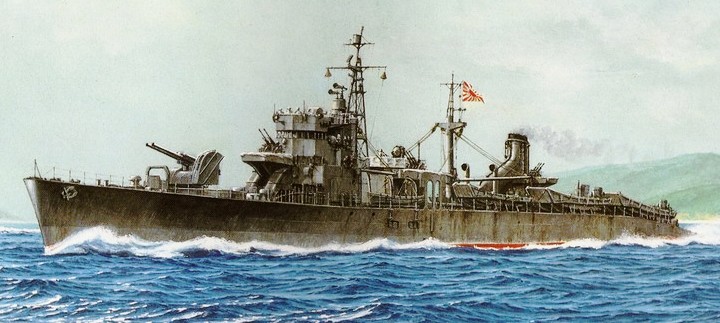Dai 1 Go-gata Yusokan
IJN No. 1 Class Fast Transport
 (No. 1 Class Fast Transport T.5 by T. Yuki)
(No. 1 Class Fast Transport T.5 by T. Yuki)
IJN Transport T.17:
Tabular Record of Movement
© 2014-1017 Bob Hackett and Sander Kingsepp
Revision 1
27 October 1944:
Kure Naval Arsenal. Laid down as Ship No. 2917, a
1,500-ton No. 1 class landing ship.
8 December 1944:
Numbered T.17
30 December 1944:
Launched and provisionally attached to Maizuru Naval District.
11 January 1945:
Lt Niwa Masayuki (68)(former gunnery officer of HAMAKAZE) is appointed the
Chief Equipping Officer of T.17 and T.18 (until 7 February).
8 February 1945:
Completed. Attached to the Maizuru Guard Force. Lt Niwa Masayuki is the
Commanding Officer.
2 March 1945:
Ourazaki Base, Kurahashi Jima Island. T.17 embarks
Type D Koryu
midget submarines HA-209 and HA-210, then departs for Unten, Okinawa.
3 March 1945:
T.17 arrives at Oura Bay, Okinawa, then proceeds to Unten.
8 March 1945:
Arrives at Unten and unloads her cargo. Both
midget submarines are assigned to Lt Kawashima Gen's 2nd "Dragon" Squadron.
9 March 1945:
Arrives at Naha and unloads a cargo of munitions, land mines and food.
Departs for Sasebo.
12 March 1945:
Returns to Sasebo.
23 March 1945:
Ourazaki midget submarine base (Base P). T.17 loads Type D "Koryu" midget submarines HA-91 and HA-92,
22 men of the No.2 Koryu Unit, 41 men of the No.3 Koryu Unit, and fuel and munitions originally intended
for the midget submarine base in Unten, Okinawa. Following the heavy air attacks in Okinawa area, the
destination is changed to Amami-Oshima, Ryukyus.
24 March 1945:
Departs Kure, carrying two Type D Koryu midget submarines and munitions
originally intended for the midget submarine unit in Unten, Okinawa. Following the heavy air attacks in
the Okinawa area, the destination is changed to Amami-Oshima.
25 March 1945:
Arrives at Sasebo. Assigned to the 31st Transport Unit. Forms temporary
Amami-Oshima Transportation Unit with Type 2 LSTs Nos.145 and 146, escorted by kaibokan CD-186
and subchasers CH-17 and CH-49. Lt Niwa is appointed the CO of that unit.
27 March 1945:
Sasebo. T.17, T.145 (Lt Nishimura Tsunao) and T.146 (Lt Nomoto Tadayuki) are ordered to carry out
an emergency transport operation between Sasebo and Amami-O-Shima.
31 March 1945:
Sasebo. The three transports are ordered to depart Sasebo later this day. The formation is designated
O-Shima Transport Unit. Lt Niwa is appointed CO of that unit. At 1800, the three transports depart
Sasebo for Amami-O-Shima, escorted by kaibokan CD-186 (Lt Kusumi Naotoshi), subchasers CH-17 (Lt Kimura
Mitsuo) and CH-49 (Lt Ijichi Shoichi). The convoy makes a brief stop in Tera-Shima Anchorage (SW of Sasebo)
later that evening and continues before midnight. CH-17 is detached en route to chase a submarine, but joins again
later.
1 April 1945:
East China Sea. T.17 rescues forty-four survivors from cable-minelayer ODATE, sunk in an air attack on
27 March (two die later). During this day, the convoy encounters a USN PBY reconnaisance seaplane, W of Tanega-
Shima.
After sundown, the convoy arrives at Kakeroma-Jima, just S of Amami-O-Shima, proceeding to Seso anchorage
via the western channel. At about 2030, while proceeding through the western channel, two American carrier bombers fly
over the ships. Disregarding Lt Niwa's orders, one of the vessels opens fire at the intruders, revealing its presence. The
planes return for a strafing attack. T.17 suffers one sailor KIA and 8 others wounded. CD-186 is slightly damaged,
but suffers no casualties.
After sundown the convoy arrives at Kakeroma Island, Amami-Oshima, proceeding to Seso
anchorage via western channel. Around 2030 two American carrier bombers fly over the anchorage on a
recce mission. Disregarding Lt Niwa's orders, one of the vessels opens fire at the intruders,
revealing its presence. The planes return for a strafing attack, killing one sailor and wounding 8.
2 April 1945:
About 0200, the convoy arrives at Seso Anchorage (28-08N, 129-16E). Unloading commences immediately.
By dawn, midget submarines HA-91 and HA-92 are successfully floated. Shortly afterwards, at 0710, about
20 Grumman carrier planes from Rear Admiral (later Admiral/Chm, JCS) Arthur W. Radford's (USNA '16)
Task Group 58.4 attacks the ships in the anchorage.
At once, all vessels open fire. Despite the tremendous AA-barrage, T.17 is hit by two bombs, detonating
spare torpedoes for the midget submarines and causing loss of 50 per cent of the fuel intended for the midget
submarines. Totally wrecked, T.17 keeps afloat almost throughout the day, but, at 2326, sinks at 28-07N, 129-09E.
CD-186 also suffers heavily. Her port and starboard side twin 25mm-MG mounts are wrecked and she is hit by two
bombs in the engine room and set afire. The engine room floods and she settles fast by her stern. [1]
Lt Kusumi, among the survivors, orders “Abandon Ship”. As all boats are wrecked the survivors have to jump
into the water. Shortly afterwards the flames reach the magazine and, at 1030, CD-186 sinks vertically with her bows
pointing skyward. 53 crew are KIA and many more wounded. CD-186 claims to have shot down 3 enemy planes
and damaged 6 more aircraft. The other vessels escape sinking, but all sustain damages.
10 May 1945:
Removed from the Navy List.
Author's Notes:
[1] It is probable that several of ODATE's survivors were still on board T.17, but the wounded were in hospital.
Thanks go to Erich Muehlthaler for info in Rev 1.
- Bob Hackett
Back
to Fast Transport Page





